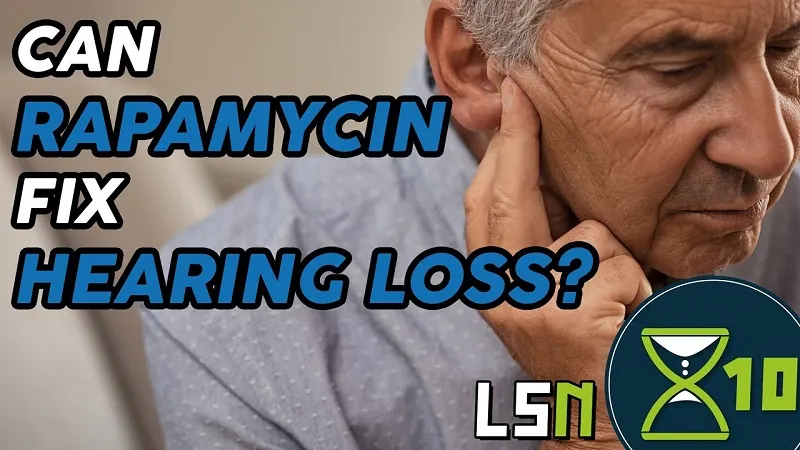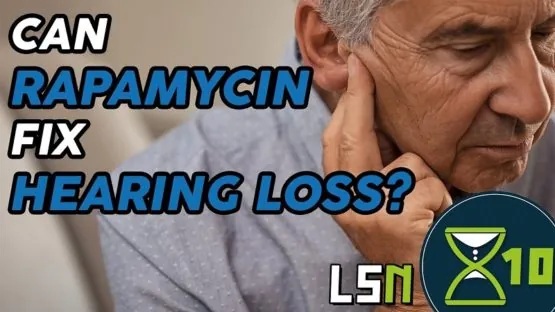This week on Lifespan News, Brent Nally discusses the use of rapamycin to treat hearing loss in a mouse model, vibration to reduce senescent cell burden in rats, a drug that has shown scar-free healing in a mouse model, the scent of food affecting caloric restriction in nematodes, and Kizoo Technology’s €300 million investment in rejuvenation biotechnology.
Further Reading
Rapamycin Reduces Age-Related Hearing Loss in Mice
Vibration Reduces Cellular Senescence in the Bones of Rats
Drug Allows Healing Without Scars in Mice
Smelling Food Undermines Dietary Restriction in Nematodes
Kizoo Technology Pledges €300 Million to Rejuvenation
Script
A new study shows that rapamycin reduces age-related hearing loss in mice; low-intensity vibration seems to positively affect cellular senescence in rats; a drug has been shown to allow healing without scars in mice. You’ll find these and more stories in this episode of Lifespan News.
Welcome to Lifespan News on X10, your source for longevity science updates. I’m your host, Brent Nally. We encourage you to check the description below for links to these stories.
Continuing with our first story, rapamycin reduces age-related hearing loss in mice. According to new research, rapamycin supplementation attenuates but does not reverse age-related hearing loss in mice even if the treatment starts later in life. The researchers of this study had previously found that age-related hearing loss was alleviated in mice who had been receiving rapamycin since they were young. Now, the researchers wanted to see if these results could be replicated with treatments later in life. The researchers found that rapamycin treatments given to mice that were 14 months old — which is equivalent to about 50 years in humans — prevented them from developing further hearing loss. However, the treatment doesn’t seem to reverse hearing loss. There was some evidence that existing damage to hair cells in the cochlea persisted. The team didn’t examine the molecular underpinnings of rapacmycin’s activity to prevent hearing loss, though the researchers speculate that it involves the drug’s effect on the endoplasmic reticulum. The ability of rapamycin to attenuate age-related hearing loss reinforces the emerging understanding that rapamycin works on a fundamental level, affecting common cellular pathways that induce various aging-related pathologies across an organism.
For our next story, vibration reduces cellular senescence in the bones of rats. Senescent cells are one of the nine hallmarks of aging and are cells that no longer divide but accumulate over time and cause inflammation. In mice, senescent cells have been shown to play a causal link in osteoporosis, which is an age-related condition that makes bones less dense and more fragile. Clearing senescent cells has been shown to increase the bone density of osteoporotic mice. Interestingly, low-intensity vibrations have been shown to be beneficial for bone growth in a variety of contexts. Sichuan University researchers wanted to see if this had any relation at all with senescent cells. To do that, the researchers ran a study using young and old rats by collecting different cell types from the rats, and unsurprisingly, cells from older rats displayed a higher degree of senescence—more DNA damage, and lower proliferation rates. Applying a 90-hertz vibration at an intensity of 30% that of gravity appeared to have made the rats less senescent, yielding benefits in cells from both aged and young rats. Aged rats exposed to the vibration also had benefits. While vibration-induced bone growth is a well-known phenomenon, the link between low-magnitude vibrations and cell senescence was unexplored. The exact mechanism at play is yet unclear, and so is whether whole-body vibration exposure may be effective in humans in general. Some trials showed that it did improve bone density in people, but others didn’t, suggesting the effect might be only mild. As always, more research is needed.
By the way, Lifespan News is released every Tuesday at noon Eastern Time, while our other science and advocacy X10 videos are released every other Monday also at noon Eastern Time. Now back to the news.
A drug allows healing without scars in mice. A team of researchers at Stanford have found out more about why we scar after injury and have shown that interrupting key cell signals during the healing process allows wounds to heal without scarring. Scars are not just a cosmetic issue. Scar tissue is a poor substitute for healthy skin, as it lacks sweat glands and hair follicles and is structurally weaker and less flexible than skin. The researchers noticed that skin tension is an important factor in scar formation. The researchers found that certain cells express the Engrailed-1 gene during scar formation. The team showed that Engrailed-1 is expressed by these cells when they sense mechanical tension in their surroundings. To test the effect on scar formation, the researchers applied tension to surgical wounds on mice. This led to increased scar formation. By contrast, treating wounds with a chemical that stops cells from sensing tension prevented scar formation. The wounds healed into normal skin, complete with follicles and glands. This needs to be tested in other model animals. If that works out, then clinical trials will likely follow.
Moving on, smelling food undermines dietary restriction in nematodes. Experiments by researchers in China and the United States have shown that the smell of food is enough to reduce the lifespan gains caused by dietary restriction in nematodes, and the same might hold true in mammals. Researchers grew C. elegans nematodes in petri dishes with and without bacteria, which is what they eat. Some of the plates had a thin layer of bacteria on the lid, so the nematodes could smell them but could not eat them. This had no effect on the lifespan for the nematodes with free access to bacteria, but in the dishes without bacteria, it caused a 50% decrease in the longevity gain from dietary restriction. In a nutshell, the smell of bacteria offset some of the lifespan extension caused by dietary restriction. The team also pieced together the neural circuit involved. The signal is carried through a sequence of neurons from the brain to the intestine – interfering with any of the neurons in the link blocked the effect of the food smell – and is mediated by the neurotransmitter octopamine, which is the invertebrate homolog of norepinephrine. Octopamine affects lifespan by regulating the energy sensor AMPK in the intestine. Finally, the researchers tested whether this signaling link is also present in mammals. The researchers studied cultures of mouse cells that are functionally similar to the nematode intestine and showed that norepinephrine activates AMPK via the same signaling pathway. Whether this is linked via neurons to the perception of smells remains an open question, let alone whether that could alter the longevity benefit of dietary restriction.
For our final story, Kizoo Technology pledges €300 million to rejuvenation. Kizoo Technology Ventures is a well-known player in the rejuvenation space. Over the past few years, Kizoo Technology has financed several rejuvenation startups, such as grapeseed.bio, Lysoclear, and Oisin Biotechnologies. The man behind Kizoo, Michael Greve, is also the founder of the Forever Healthy Foundation, which is one of the organizers of the Undoing Aging series of conferences. In a recent press release, Michael Greve has announced that his pledging of an additional 300 million euros, which is roughly equivalent to 360 million US dollars, to be invested in rejuvenation research. According to the release, “With this €300 million commitment, Greve and Kizoo double down on their mission to accelerate the advent of rejuvenation biotechnology by doing lighthouse investments in entirely new, repair-based approaches that treat the root causes of aging and thus overcome age-related diseases. Through the creation of successful companies, they seek to inspire scientists, investors, and the general public by demonstrating that human rejuvenation is not science fiction anymore and that the resulting therapies are affordable and uncomplicated.” Thanks to Kizoo and Michael Greve for their continued support to this cause! If you want to learn more about Kizoo, check the description below.
That’s all the news for this video. Is there a recent life extension story that we haven’t covered yet that you think we should have? And what was your favorite story from this video? Let us know what you think in the comments below. We really appreciate it and we look forward to seeing you in the next video at least as healthy as you are now.



